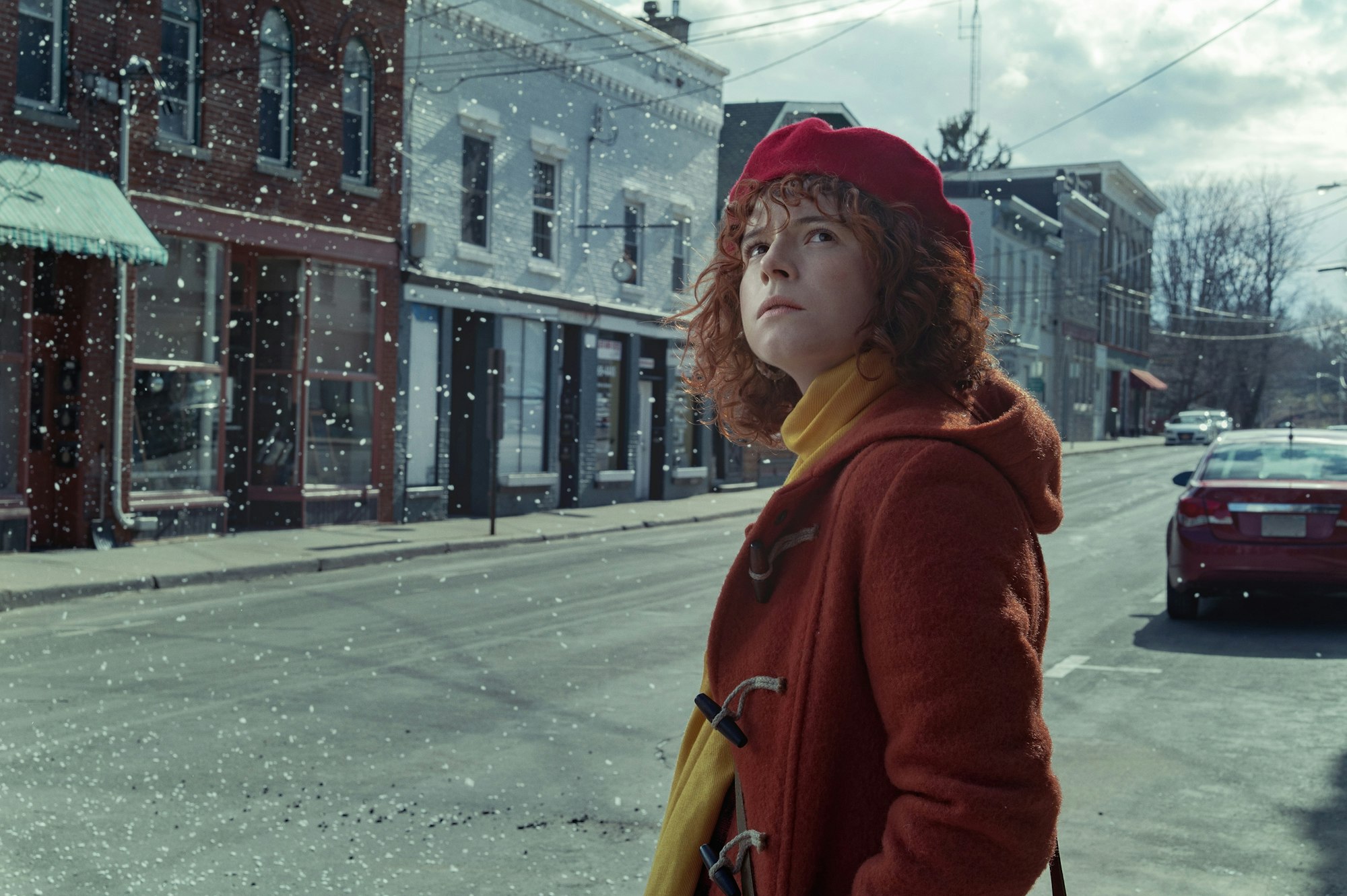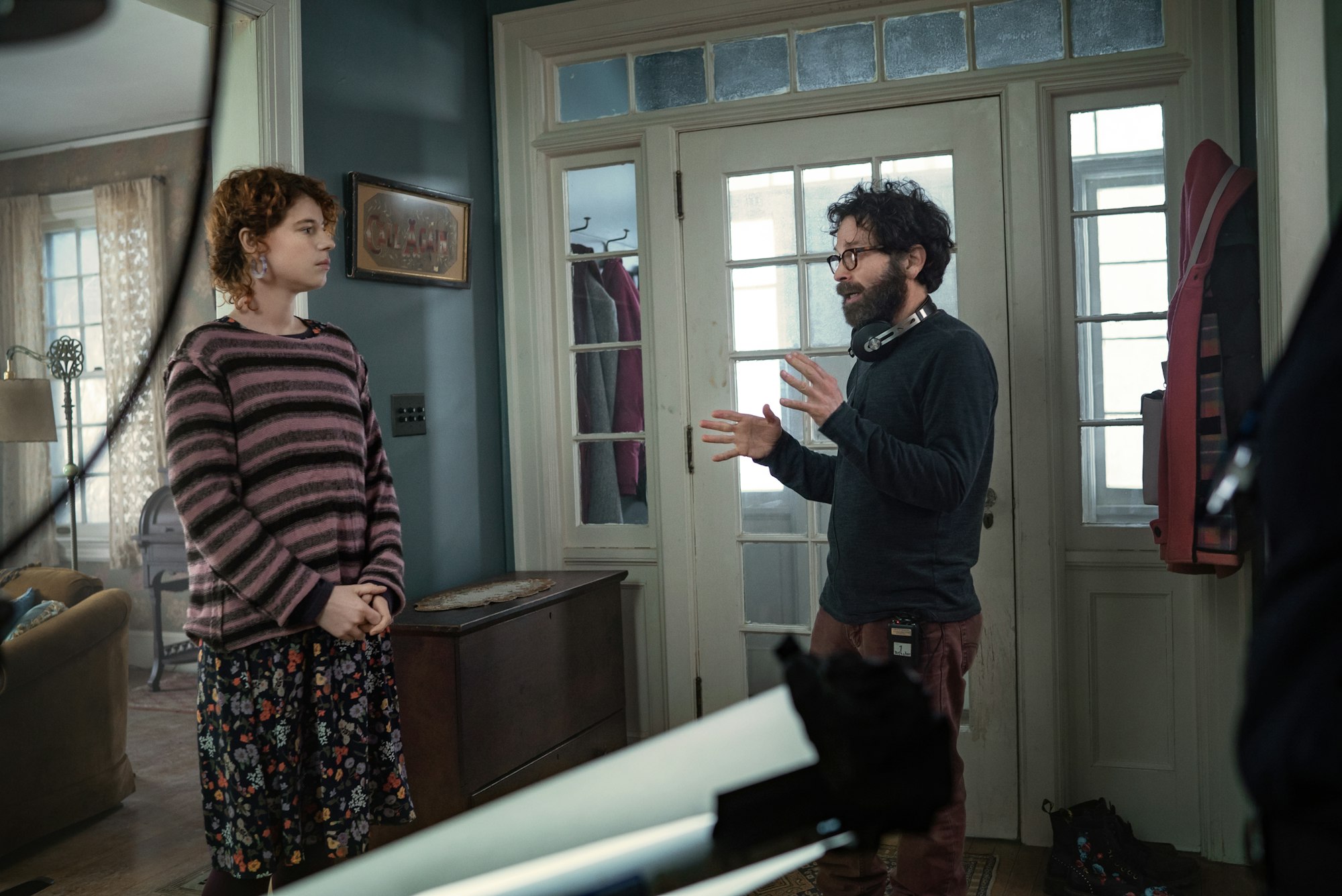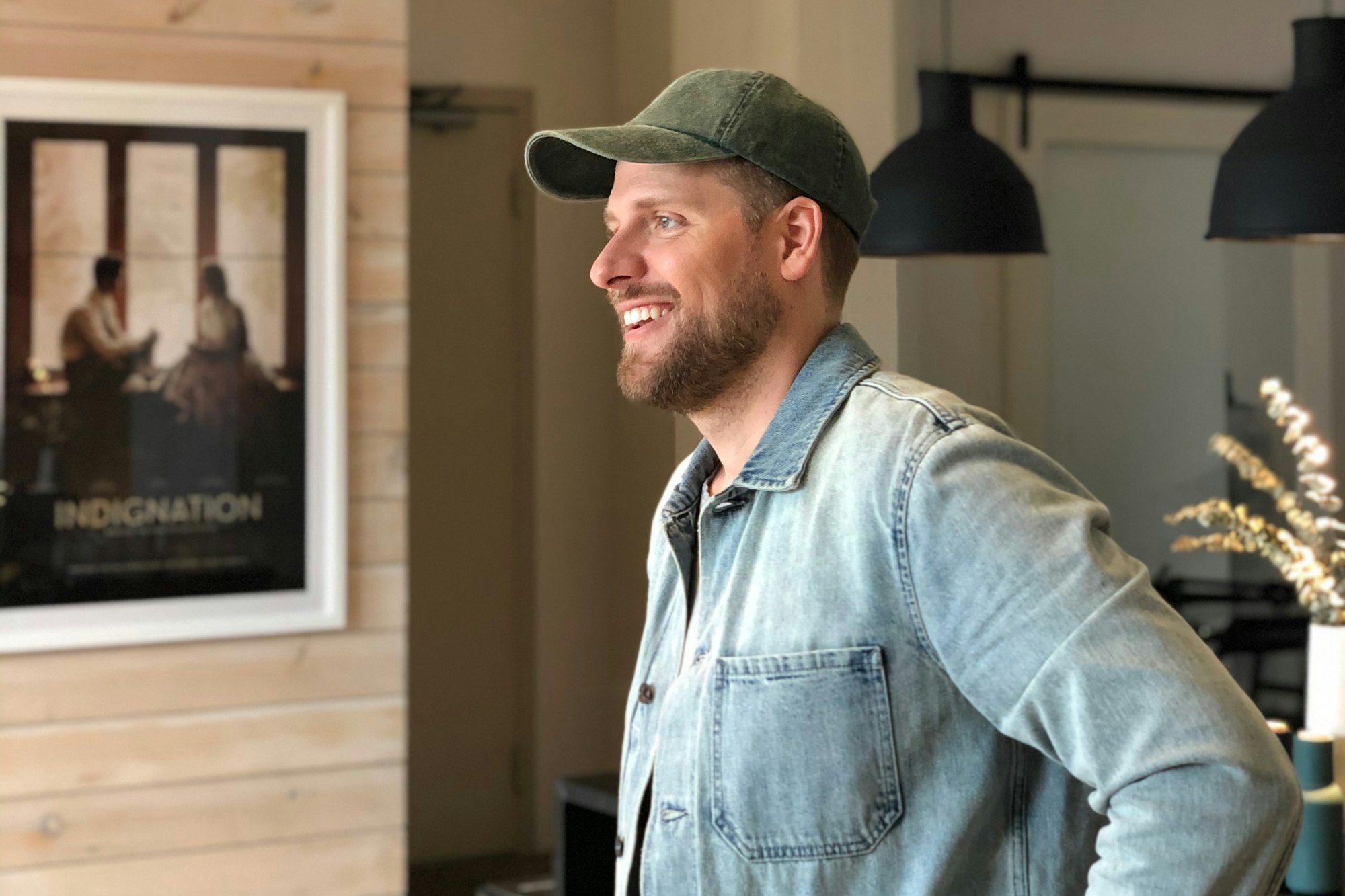Words by Amon Warmann
The only guarantee in a Charlie Kaufman movie is that sooner or later things are bound to get surreal, and his unique filmmaking sensibilities have produced equally distinctive scores from the likes of Carter Burwell and Jon Brion. I’m Thinking of Ending Things, which debuts on Netflix this week, is no different, only this time it’s Jay Wadley who’s on music duties.
The New York based composer has been racking up a steady list of credits in narrative films and TV shows since 2009 and leapt at the chance to work with Kaufman. While on the surface the film’s premise seems basic – a young woman (Jessie Buckley) takes a wintery road trip with her new boyfriend (Jessie Plemons) to meet his parents – in reality it’s anything but.
When we caught up with Wadley, we talked about how his director’s unusual screenplay changed his creative process, what the freedom of experimentation led to, and much more.
*This interview contains spoilers for I’m Thinking of Ending Things.

When did it click for you that film composing is something you wanted to do?
I started composing and writing for my bands back in high school and got into classical music for a while, and then ended up studying classical composition in grad school. I was always interested in film scores, but I didn't actually start taking an active interest in potentially scoring for film and TV until I got to grad school. So that's kind of when I started learning how to score to picture and just experimented with those things because I hadn't had any experience up to that point. Lie To Me [a 2009 TV series starring Tim Roth] was the first time I ever scored to picture. I was an additional music composer on that working under head composer at the time Doug DeAngelis. I was kind of thrown into the deep end – working on a network TV show, you have to learn how to do it right at an aggressive pace.
How did you land the I’m Thinking of Ending Things gig?
Anthony Bregman [a producer on I’m Thinking of Ending Things] is the one who reached out to me. He and I had worked together before on the film Indignation back in 2016, so that's how we had gotten to know each other. He was just like “can I interest you in a Charlie Kaufman movie?” And my jaw dropped and I probably passed out. I did not see that coming. There were a lot of very specific things that he wanted in the score that he felt were really uniquely suited to my experience and my background, which was pretty cool.
I read the script and then had a call with Charlie Kaufman, just to start to get some ideas together as to what sort of approach we’d want to take with it and it seemed like we were on the same page pretty quickly. We had to move fast because I had to write a bunch of stuff prior to shooting. So the ballet and the sort of 1950’s style, weird jingle that they sing on camera – all of that stuff had to be completely written prior in order to shoot with it.
I gather you were a big Kaufman fan before you signed on to this. Did you revisit any of his other films prior to beginning your work?
I was very familiar with all the scores for his past films and obviously familiar with his tone of voice and the things he focuses on thematically, but me working on a Kaufman film is not something that I thought was in the realm of possibility. I would say that the other scores didn't have much effect on how I would approach this film per se, because, you know, it's just such a different film than the other films he's done. It's got an unsettling creepiness to it, but it doesn't fully commit to being a horror film. Typically I'm not as much of a horror fan as I am of psychological drama. I really love the challenge of having to figure out what the hell's going on and having to go back and watch it, and that's one of the things I just always admired about Kaufman’s films. With every single watch it's like an onion, you just peel back and there's another layer and it just gets deeper.
This score demanded a very particular approach, and I wouldn't want to try to live in the world of Jon Brion or Carter Burwell and try to do something that would sound like them. I wanted it to be wholly my own unique voice to bring my own sensibilities to it because I think if I had tried to, you know, do what they do for a Kaufman film, it would be very different.
This film had very unique requirements; writing the ballet and how that would be fleshed out in various parts throughout the film, and doing the jingle and then doing a sort of a pastiche like rom-com score for the film within the film. Then when we decided there was going to be more score in the editing process, we had to chop up the ballet and make it this sort of fever dream-ish, memory piece. That echoed some of the thematic content and the construction of the film itself.
I have a classical background and I got to exercise those muscles again. Composing music that exists on its own and not as an accompaniment so that it can have its own moment to shine was super exciting to me.
It sounds like the unusual nature of this film altered your normal creative process.
Yeah. One of the great aspects of it is there wasn't really a lot of temp score, so there wasn't something I really had to, you know, live up to being able to write before it shot. With the ballet, I got to create this entire world just based on Charlie's scene description of the sequence. I got to imagine what that would be and figure out how to space that out in time, and that was something I've never had the opportunity to do up to this point.
I have a classical background and I got to exercise those muscles again. Composing music that exists on its own and not as an accompaniment so that it can have its own moment to shine was super exciting to me. And then I think what was very unique but also very helpful on this film’s post-scoring process was that I already had all of this material that I got to mash up for all of that stuff in the final sequence. Parts of the ballet and the jingle are reversed and stretched out, and there's all these various layers of references to other parts of the score that are kind of coming together and synthesising into this crazy fever dream of a piece.

I’m Thinking of Ending Things is as notable for its lack of music for long stretches as the score itself. What conversations did you have with Kaufman about that?
From the get go, he was very adamant that this was not supposed to be a typical horror score and it wasn't really a horror film, but it dips its toes in it. In a way it is extremely unsettling, but it's kind of because we're forced to sit with these extremely uncomfortable and difficult conversations and these confusing moments of the girlfriend's name changing all the time, and her studies changing all the time. It's like what is happening? Who are these people and how are they actually interlinked? And so, you know, it was really clear to Charlie upfront that he didn't want to go the heavily scored horror film route.
And we weren't sure how much of an actual post-scoring process there would actually be. The things we knew were going to be in there was the jingle, the score for the score within the film, the ballet, the Oklahoma musical stuff… once we established those things and got into the editorial process we found places where they would fit. The ballet, for instance, actually worked really well in a different form as the opening score. And then we also place it in the house on the record player. So it's kind of like playing with these multiple layers of depth where the score actually lives and exists. You hear it diegetically, you hear it as score, and then you hear it as a dream ballet sequence that also somewhat exists in the mind of the main character as a dream sequence.
So we started to find that way of approaching the score once we got into the editorial process, and then it became clear that we would want some type of score to play out certain scenes or to drop a few hints early on. The moment where Jessie Buckley’s character walks down into the basement, for instance, or when she first walks into the school – that’s parts of the ballet stretched out, or reverse reverb-ed out. So it's always hinting at this ultimate place where the film kind of starts to really have this focused trajectory towards the end.
And then being able to take all of those elements and create that final fever dream piece… that was something that wasn't clear we would need either, so all of that stuff kind of came to be once we got into the edit. It was clear there was room for it because Charlie really wanted this film to, you know, force people to sit with all of these different concepts for a while. So we just felt like score was going to detract from that, at least in the first half of the film.
There were versions that were more heavily scored that we ended up paring back to simple elements that still have the connective tissue.
I get that. There's such a less is more vibe to this score. How much of a challenge was it to do minimalism effectively?
It's definitely a difficult balance. There's a lot of throwing things against the wall and seeing what sticks and then starting to pare it back. There were versions that were more heavily scored that we ended up paring back to simple elements that still have the connective tissue. It doesn't have to be something that is at the forefront. It just slightly colours the situation and colours the scene. Obviously then towards the end, I got to play a little bit more of an apparent role in the narrative.
I think we found the balance there, you know, with being able to have the space that all of the elements needed to be able to speak and breathe and sit with the uncomfortableness of the entire film. But we also have a few moments that really shine or benefit from something there. It's funny because music takes a backseat for a majority of the film, and then all of a sudden it just gets its spotlight. I really enjoy how it turned out.

The final sequence you keep alluding to has an interpretive dance, an animated ghost pig, and a naked old man. Where do you start with that when you read that in the script?
Luckily I got to deal with each of those things independently on their own at first. So, before we get to the naked man following an animated pig sequence where things really go off the rails, I got to really focus on the ballet. I'm glad that I got to do that in stages because I think it would have been very difficult to try to approach that all in one fell swoop and make it as dynamic and crazy as it ended up being.
When we got to the point where we were actually working on post-scoring, I had also already done the jingle. That jingle initially appeared in the script far earlier in the film and didn't appear during that sequence. But it's sort of a transition point into the animated pig. I thought that scene was absolutely insane, and I figured it would probably need score. We were trying to figure out a few things. What point in time does the ballet trickle out at the tail end? When does the score come in and lead us through the end of the film? What is its function and why is it there? It was mostly textural stuff, and the jingle is sort of the real pivotal point that transitions us into this hallucinogenic sequence that leads us to the end with a bass and harp and a really low, tubular bell sort of hit.
From that point, all of the material through that section is just all of these sort of fragmentations. The jingle itself is twisted and certain parts were looped on end and then run through a tape recorder and paused and rewound. But then we transition into this whole speech sequence, which is a direct lift of a speech from A Beautiful Mind. [Jessie Plemons’ character] is giving this speech imagining a much better life for himself in a way and so the score kind of starts to dip into that territory with him all the while keeping elements of the ballet. Then the actual score for that speech is then also run through a tape recorder. I wanted it to feel like synapses misfiring, like all these memories are getting mashed into each other in an interesting way. So that was the concept behind that final piece.
It sounds like you got to do a lot of experimentation due to the nature of the project, which you clearly really enjoyed.
Yeah, definitely. And, you know, Charlie was really, really open and supportive of that. He had things that he definitely did not want. But yeah, I kind of got to do a lot of playing. The experimentation part of writing the ballet was so much. But that also is supposed to be a piece that is somewhat reminiscent of Debussy or Ravel or Stravinsky. Because the whole concept of the film is that Plemons’ character is referencing literature and art and film from other things and kind of bringing it into his own narrative and presenting them as if they're his own ideas. He's imagining this other alternative life he could have had and it's tragic, so my concept with the ballet was kind of building off of that. So he’s heard Debussy. He's heard Ravel. He's heard Stravinsky. So when he starts to dream up his own story and his own dream ballet, these are the types of composers he pulls from.

There’s a lack of Black and female composers in the industry. Why do you think that is and what can the industry do to improve the situation?
There's just institutions that have not really done the work to actually bring in a diverse group of composers from all different types of backgrounds. And unfortunately, that history goes so, so far. It starts at every level. We need to make sure that there's opportunities there for people that may not have the initial connection to get into the music school or whatever, and that people are actually supporting those things at an early level. And then that there's actually representation at the top levels for the people who absolutely deserve to have their moment and to have their work seen and appreciated by all.
I feel like I need to be not the leader of the charge, but one to help support and lift other people up. I’ve tried to do that as best I can. And I think that institutions have to take responsibility for that and to do the work and not be lazy about it, because I think that's part of it too. There's a tendency, I think, to be lazy about it and not actually do the research. It's not okay to say I can't find a person of colour to score this film. It's not true. It's just absolutely not true. It's just laziness.
What’s next for you?
Well, I have another film coming out later this year. It's a Sony Pictures Classics film called I Carry You With Me directed by Heidi Ewing. She's been known for her documentary films like Jesus Camp and Detropia, but this is her narrative debut that premiered this year at Sundance and won the Audience Award and the Innovation Award. It's a beautiful love story spanning 20 years and two countries about these guys who met and fell in love in Mexico and travelled to New York City to pursue dreams of opening a Mexican restaurant. So really excited about that one coming out.
I’m also doing kind of a crazy experimental doc right now called Light Darkness Light about a priest who lost his sight and in Canada and goes through a an experimental surgical procedure to learn to see through like a digital eye. So it's a really crazy story and he's a really interesting character. So that one's fun. I’m just excited for when we're able to really get back in the swing of things here after COVID.
Photos by: Mary Cybulski/Netflix
